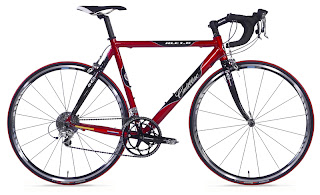A customer wearing bizarre, skin-tight clothes was paying an older man who was similarly attired. He wheeled his bicycle out the door, and took off. Then it was just the four of us, in a tiny shop with shiny new bicycles hanging from the ceiling. “Can I help you boys?”
Hm. British.
“Yeah. Why are your bikes so expensive?”
“Well,” said he, “these bicycles might cost a little more than what you’re accustomed to paying, but there are some appreciable differences between these models and the ones you’re riding.”
“Such as?” I can’t remember which of my friends said those magic words, but they opened up an entire afternoon to a tutorial on the finer pleasures of purchasing and riding a refined set of wheels. Chromoly frames; double-butted tubing; alloy rims; side-pull brakes, versus the gimpier center-pull ... am I missing anything? Oh yeah: the clothes. Sweat-wicking, less wind-resistance and whatnot. Sneakers vs. cycling shoes, the difference between hitting a sponge ball vs. hitting a cricket ... erm, baseball.
For the middle-aged gent who was lecturing us, this was simply the well-trod method of introducing three lads to a potential “Life Sport” (the lingo of the day). For three guys on the cusp of 20, this was stuff — cool, shiny, new stuff. Within a week, my friends were riding a couple of flashy, deceptively fragile-looking bicycles. I opted for a used motorcycle, but eventually traded that in for the mountain bike.
Having been informed that my current bike is cruising toward an expensive breakdown, and having been assured by my daughters that lengthy rides are soon to come, I’m slouching back to the bicycle store. My, how things have changed. My old bike, which cost nearly a grand 20 years ago, is a heavy monster compared to what’s currently on offer. And forget side-pull, center-pull, and them new-fangled cantilever brakes of mine: disc brakes are all the rage, apparently.
As with stereo stuff, I’m now disinclined to indulge a salesmen or do much by way of product research. My first impulse, when informed of my bicycle’s dire state, was to visit the Costco website to see if they didn’t have something I mightn’t pick up on my next shopping trip. I discovered, to my surprise, that Costco is selling Cadillacs.

Yep: Cadillac bicycles.
I chuckled, and moved on to the next site. Then, on second thought, I took another look. After all, it’s not like General Motors is actually manufacturing the bicycle — they’re just branding someone else’s work. The 20 year old geek within me woke up and wondered: What sort of frame are we talking about? And who supplies the components?

On closer inspection, the Cadillac bicycles appear to be reasonable “mid-list” bikes: they're being compared to the Schwinn bikes of old (the original “Cadillac of bicycles“), and that’s no small compliment: Schwinn bikes were sturdy, conservatively constructed bicycles that most people could buy and ride to the end of their days. Cadillac offers a similar package, with carbon frames and decent componentry that is priced in line with brand-name bikes offering similar fare.
So, is there a Cadillac in my future? Not likely. Frankly, the brand is a sharp disincentive. I live in a small town, and I’m not keen on being the guy whose car is a Toyota and whose bicycle is a Cadillac.
On some level, a Cadillac brand bicycle is counter-intuitive, particularly in contrast with, say, the Hummer bicycle. If you're the sort to buy a yellow H2 (or whatever number they've reached these days), you’re likely the sort to think a matching bicycle on the roof rack is a good thing. But even an off-road cyclist could be forgiven for being reassured by the brand. HumVees are (ostensibly) off-road vehicles; you needn’t own the car to be persuaded of the bicycle’s off-road merits. Which gets me wondering: who, exactly, was the Cadillac bicycle meant to appeal to?
Best guess: Cadillac SUV customers. If they get a thousand-dollar bike thrown in with the new Escalade, well, bonus! Except most Escalade customers are likely to turn their noses up at any bike that sells for a measly grand. So we’re left with GM assembly-line workers who can buy the bike at cost, or Costco customers caught in the throes of (as marketers like to say) an aspirational impulse.
No thanks. Unless Cadillac undercuts its immediate competition (Trek, Fisher, etc.) and drops another $300-$400 off its price tag, I believe I’ll go brave the bicycle salesmen instead.
Post-script: this guy points out that Cadillac bicycles are built by the same people who manufacture the Tonka and My Little Pony bicycles you find at Sears. “My Little Pony“ — now there's a brand I'd love to ride around this town!

3 comments:
Hey, WP, nothing wrong with that last pictured model especially that colorful chain guard and training wheels. Aging is a circle and choice of bikes is circling back to those early childhood days of perpetually riding at a 45 degree angle...
.... on training wheels.
Somehow, I just can't picture the typical Escalade driver being caught dead on a bicycle. Though he may find the bicycle useful once the Escalade gets repossessed. Supposedly, repo men make a fine living off of Escalades, as the buyers are the type who'll run right out and get a $10K set of rims but won't bother with those pesky monthly car loan payments.
The repo-man wasn't an element in my equation, so now I'm guessing he just nabs the bicycles, too - Caddy and My Little Pony alike.
Post a Comment